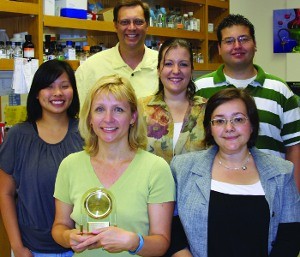A new study led by Weill Cornell Medical College scientists shows that Fragile X syndrome occurs because of a mechanism that shuts off the gene associated with the disease. The findings, published today in Science, also show that a compound that blocks this silencing mechanism can prevent Fragile X syndrome – suggesting a similar therapy may be possible for 20 other diseases that range from mental retardation to multisystem failure.
Read moreautism
Molecular mechanisms: Enzyme blockers help Fragile X mice
Dr. Jope won the 2013 FRAXA Pioneer Award for this work. The mood stabilizer lithium and two other drugs that block an enzyme called GSK-3 reverse cognitive deficits in a mouse model of Fragile X.
Read moreSocial Behavior as an Outcome Measure for Fragile X Clinical Trials

One of the features of the Fragile X mouse model which is relevant to the human Fragile X syndrome (and autism) is social behavior. Several tests show consistent social behavioral abnormalities in the Fragile X mouse model. With a $140,000 grant from FRAXA Research Foundation in 2012-2013, Dr. Willemsen at Erasmus University used social behavior tests to measure the effectiveness of several drug strategies.
Read moreGlycogen Synthase Kinase-3 (GSK3), Lithium and Fragile X

With $208,000 in funds from FRAXA Research Foundation, Dr. Richard Jope and his team at the University of Miami tested whether newly developed, highly specific inhibitors of GSK3 can reduce behavioral abnormalities in Fragile X mice.
Read moreThe mTOR Pathway in Fragile X Syndrome
With a $90,000 grant from FRAXA Research Foundation over 2012-2013, Dr. Eric Klann and Postdoctoral Fellow Dr. Aditi Bhattacharrya of New York University investigated alterations in the mTOR pathway in Fragile X syndrome – which is also known to be defective in several forms of autism. Their work was published in September 2012 and received international attention.
Read moreFragile X Treatment Strategy Emerges from FRAXA Research: IGF-1

New Zealand-based biotech Neuren Pharmaceuticals has announced impressive preclinical results in the Fragile X mouse model with Trofinetide. These compounds are examples of a new class of drugs based on insulin-like growth factors (IGF-1). IGF analogs are currently considered the most promising approach for treating Rett Syndrome, a fatal genetic disorder that affects only girls, and one of the other leading genetic models for the study of autism (along with Fragile X). The surprising news is that FRAXA researchers have found that this treatment strategy works even better in Fragile X knockout mice than in Rett syndrome mice! FRAXA’s strategy is to find and target the critical bottlenecks which block the way to development of treatments.
Read moreEffects of minocycline on vocal production and auditory processing in a mouse model of Fragile X

With $135,000 in grants from FRAXA Research Foundation over several years, Dr. Khaleel Razak and Dr. Iryna Ethell explored robust biomarkers relevant to the FXS and the efficacy of minocycline treatment.
Read morePhase 2b Clinical Trial of Arbaclofen in Autism Has Disappointing Results
Phase 2b clinical trial of Arbaclofen in Autism Seaside Therapeutics reports the study did not show improvement on the primary endpoint of social withdrawal, but it did demonstrate improvement on the Clinical Global Impression of Severity scale.
Read moreWhat Works, and What Doesn’t
At the start, it’s always hard to know what methods will work best for something as complex as the development of disease-modifying treatments for Fragile X. But, we’ve always tried to let the science lead us down the right path. At this point, the results are unequivocal, and they have shaped how we are looking for the Next Great Thing in Fragile X treatments.
Read moreReward Function in Fragile X Syndrome

With a $82,500 grant from FRAXA Research Foundation in 2011-2012, Dr. Christopher Cowan and Dr. Laura Smith explored the role of specific signaling pathways in drug-related behavioral deficits, including determining the role, if any, of known impairments in the Fragile X brain.
Read moreInherited Channelopathies in Cortical Circuits of Fmr1 KO Mice

With this two year award of $90,000, Dr. Zhang and Principal Investigator Dr. Andreas Frick at Neurocentre Magendie in France investigated channelopathies using Fragile X mice. Many other proteins are misregulated as a result of the absence of FMRP. It is known that many ion channels, the pores in the cell membrane which allow neurons to conduct electrical impulses, have altered levels in Fragile X. This state is sometime called a “channelopathy” in the pharma world. This group is studying the effect of specific alterations in ion channels, and potential therapeutic effects of drugs which open and close these channels.
Read moreCompound that Inhibits mGluR5 Corrects Signs of Fragile X in Adult Mice
A study finds that a new compound reverses many of the major symptoms associated with Fragile X syndrome (FXS). The paper is published in the April 12 issue of the journal Neuron, describing the exciting observation that the FXS correction can occur in adult mice, after the symptoms of the condition have already been established. Previous research has suggested that inhibition of mGlu5, a subtype of receptor for the excitatory neurotransmitter glutamate, may ameliorate many of the major symptoms of the disease. This study, a collaboration between a group at Roche in Switzerland, led by Dr. Lothar Lindemann, and Dr. Mark Bear’s MIT lab, used an mGlu5 inhibitor called CTEP to examine whether inhibition of mGlu5 could reverse FXS symptoms.
Read moreSpreading Sunshine
When a woman named Doris Buffett decided to embrace us, her warmth spread over us like a blanket, and the impact of her presence was immediate. As mothers and fathers of Fragile X children, we felt encouraged by the light Doris cast our way. We felt honored that the Sunshine Lady and her Foundation directors chose to invest in our children and our future. We were reinvigorated because of her generous financial support and her profound vision. Doris called FRAXA “The Gold Standard” in grass roots charities and donated more than $3 million to FRAXA in challenge grants. With our deepest gratitude, we are once again thanking Doris Buffett’s Sunshine Lady Foundation for her latest gift.
Read moreFragile X Research Grants and Fellowships Funded 2011
In 2011, FRAXA awarded $1,054,286 in Fragile X Research. Each year FRAXA holds a competition to find – and fund – the most promising new projects aimed at discovering targeted, effective treatments – and ultimately a cure – for Fragile X and related autism spectrum disorders. Each team has a page on this website with details. Our competitive grant-making process ensures that the best and most innovative research gets supported, that new scientists join the Fragile X field, and most important – that we get closer to a cure. FRAXA aims to advance the kind of translational research that is most likely to lead to improved treatment.
Read moreGABAergic Inhibitory Function in Fragile X Syndrome

With a $100,000 grant from FRAXA Research Foundation, Drs. Joshua Corbin and Molly Huntsman from the Children’s National Medical Center examined the role of a particular class of brain cells (inhibitory interneurons) that dampen excessive activity in the “emotional center of the brain” (the amydala). This inhibition is deficient in Fragile X, and so they are looking for ways to remedy this. This is particularly interesting to parents of children who are overly anxious and emotional. They worked with Dr. Walter Kaufmann, a clinician at Kennedy Krieger Institute in Maryland.
Read moreNeuromotor Outcome Measures for Clinical Trials in Fragile X Syndrome

With a $35,000 grant from FRAXA Research Foundation, Dr. Nicole Tartaglia from the University of Colorado Denver and Tracey Stackhouse aimed to develop neuromotor outcome measures for use in clinical trials in FXS, and to contribute to a deeper understanding of the neuromotor issues involved in FXS. This collaborative project was completed at the two sites of the Colorado Fragile X Clinic: The Children’s Hospital and Developmental FX. Dr. Nicole Tartaglia is the Medical Director of the Fragile X Clinic at The Children’s Hospital of Denver. Tracy Murnan Stackhouse, MA, OTR is the co-founder of the Developmental & Fragile X Resource Centre (Developmental FX), a clinic specializing in Fragile X.
Read moreSmall Molecule Modulators of Lithium for Treatment of Fragile X Syndrome

With a $219,500 grant from FRAXA Research Foundation, Dr. Stephen Haggarty from Havard/MIT developed a high-throughput drug screen to find compounds that inhibit GSK3, a critical enzyme in Fragile X. He looked for compounds that can accomplish this either alone or in combination with lithium, offering the possibility of enhancing the effectiveness of lithium as a treatment. His drug screen used patient-specific neural progenitor (NP) cells derived from human induced pluripotent stem cells (iPSCs) – which are created from cells in a skin biopsy from people with Fragile X syndrome (FXS) and other autism spectrum disorders.
Read moreAberrant Behavior Checklist in Fragile X Syndrome

With a $10,000 grant from FRAXA Research Foundation, Dr. Hessl at the University of California at Davis led a collaborative study to analyze the Aberrant Behavior Checklist (ABC) as an outcome measure for children and adults with Fragile X syndrome. Results published.
Read moreResults of First Fenobam Trial in Adults with Fragile X Published
We are pleased to announce the publication of positive results of a Phase IIa clinical trial of fenobam in Fragile X. Fenobam belongs to a class of compounds known as mGluR5 antagonists. Neuropharm, a specialty pharmaceutical company based in the U.K., received Orphan Drug Designation in the US in 2006 for fenobam in the treatment of Fragile X, after acquiring rights to relevant data on the compound from FRAXA. This trial was conducted in the US by Drs. Randi Hagerman of the UC Davis MIND Institute and Elizabeth Berry-Kravis of the RUSH University Medical Center, and initial results were first announced last summer.
Read moreRole of Matrix Metalloproteinases (MMP-9) in Fragile X

With a $220,000 grant from FRAXA Research Foundation over 3 years, Dr. Iryna Ethell from the University of California at Riverside studied the regulation of dendritic structure by matrix metalloproteinases and other extracellular signaling pathways. This work identified a major treatment strategy for Fragile X with the available MMP-9 inhibitor, minocycline.
Read more3 Researchers Honored at FRAXA Investigators Meeting
Over 150 scientists from around the globe gathered in Durham, New Hampshire, for FRAXA Research Foundation’s Investigators Meeting on September 21-24, 2008. They came from Australia, Canada, India, Turkey, the U.S., and eight European countries. Their common goal: “to share, collaborate and publish,” in the words of FRAXA’s Medical Director, Michael Tranfaglia, MD, to find effective treatments and a cure for Fragile X, the foremost inherited cause of mental retardation and autism. Most of the attendees were university-based professors, postdoctoral fellows, and graduate students who have FRAXA research grants. Also participating in the meeting were scientists from the National Institutes of Health (NIMH, NICHD, and NINDS), Neuropharm Group PLC, Hoffman LaRoche Inc., GlaxoSmithKline, Indevus, and Seaside Therapeutics, as well as 20 parents of Fragile X children.
Read moreAltered Cyclic AMP Signaling in Fragile X

With $125,000 grant from FRAXA Research Foundation over 2006-2008, Dr. Anita Bhattacharyya at the University of Wisconsin Waisman Center investigated abnormalities in cyclic AMP signaling in Fragile X syndrome. Results published.
Read moreFRAXA Contributes $10,000 to NIH grant to Seaside Therapeutics

Randy Carpenter, MD Principal Investigator with Mark Bear, PhD, MIT Co-Investigator (2007) conducted a clinical development of mGluR5 antagonists to treat Fragile X Syndrome and Autism. Seaside Therapeutics received a major grant from the NIH, with additional funding from FRAXA and Cure Autism Now (CAN) to develop STX107, a selective mGluR5 antagonist, as a treatment for Fragile X. Unfortunately, Seaside has since discontinued development of STX107.
Read moreElectrophysiological, Biochemical and Immunohistochemical Characterization of Kv3.1 in Auditory Brainstem Nuclei in the Fragile X Knockout Mouse

With $80,000 in funding from FRAXA over several years, the Yale University team of Leonard Kaczmarek, PhD showed that loss of FMRP leads to an increased Kv3.1 potassium currents. This change impairs timing of action potentials in auditory neurons (and likely others throughout the brain).
Read moreSocial Deficits in Fragile X Syndrome: Do Gene-Gene Interactions Play a Role?

With a $100,000 grant from FRAXA Research Foundation from 2005-2006, Drs. Jean Lauder and Sheryl Moy at the University of North Carolina looked for gene-gene interactions in Fragile X syndrome.
Read more
